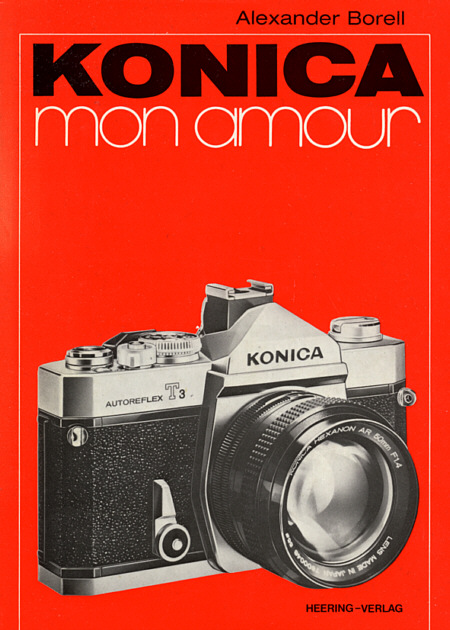This booklet is quite remarkable in several respects. Above all
it demonstrates how much our thoughts and feeling did change during the
past decades. The book title probably was intended to signal a cosmopolitan
view of the world as it is clearly reminding of the much more serious cinema
movie "Hiroshima - mon amour" Nowadays this might easily be regarded as
inappropriate.
The readers are guided through the 175 book pages by the fictitious couple Monica and Ronny.
Monica, in typical 1970s' gender behaviour, explains that she bought this Konica camera
simply because its name was so similar to her own first name!
Ronny continues by telling the readers that it was of utmost importance to
always take the camera along when going outside. The somewhat bizarre
documentation of a terrible car accident is used to explain that one might make
a lot of money in those cases by selling fresh accident of photographs to an
insurance company. Further examples are mini skirt photographs (which are
considered as a criminal act today) and the documentation of a motor boat turnover
accident.
Alltogether the storyline and presentation type might be considered as entertaining
and amusing but somewhat bizarre as well.
Nevertheless we are going to following Monica and Ronny, not by making mini skirt scenario photographs
but instead by using their macro technique for tardigrade photography (part I, as shown here).
The next issue (part II) will present the results gained by means of a more elaborate bellows/dedicated
repro objective combination and part III with a classical microscope setup will conclude
the small series.
So, let's start with the consumer macro objective technology of the 1970s:
|
![[Title fragment 1.1]](./t1_1.gif)
![[Title fragment 1.2]](./t1_2e.gif)
![[Title fragment 1.3]](./t1_3e.gif)
![[Title fragment 3.1]](./t3_1.gif)
![[Title fragment 3.2]](./t3_2.gif)
![[Title fragment 3.3]](./t3_3e.gif)
![[Title fragment 1.1]](./t1_1.gif)
![[Title fragment 1.2]](./t1_2e.gif)
![[Title fragment 1.3]](./t1_3e.gif)
![[Title fragment 3.1]](./t3_1.gif)
![[Title fragment 3.2]](./t3_2.gif)
![[Title fragment 3.3]](./t3_3e.gif)

![[ Konica "Hexanon" macro objective (55/3.5) ]](./feb2015/hexanon.jpg)
![[ Sony Nex-5N camera with Hexanon macro objective ]](./feb2015/nex mit hexanon.jpg)
![[ Photomicrograph, made by means of a Sony Nex-5N camera equipped with a Hexanon macro objective ]](./feb2015/fingerabdruck.jpg)
![[ Photomicrograph, made by means of a Sony Nex-5N camera equipped with a Hexanon macro objective ]](./feb2015/stempel.jpg)
![[ Photomicrograph, made by means of a Sony Nex-5N camera equipped with a Hexanon macro objective ]](./feb2015/bluetenzauber.jpg)
![[ Tardigrades and 1 Cent coin, photographed by means of a Sony Nex-5N camera equipped with a Hexanon macro objective ]](./feb2015/challenge.jpg)
![[ Tardigrades, photographed by means of a Sony Nex-5N camera equipped with a Hexanon macro objective ]](./feb2015/DSC04037de.jpg)